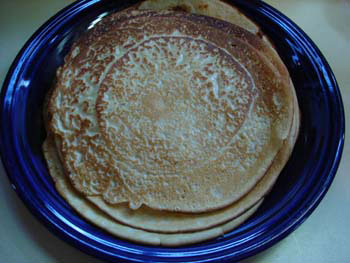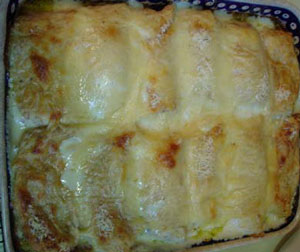 Crêpes
Crêpes
Taking another stroll down memory lane led me to a decision to make crêpes for dinner tonight. When I worked at the Watergate Hotel back in the ‘70s, crêpes were a staple on the menu, served at lunch every day and brunch on the weekends. Thus it would fall to one of us hapless apprentices to replenish the supply every other week or so. We mixed up eggs and milk in a big 5-gallon bucket with an 18 inch long whisk and then added flour until the batter was the right consistency—about as thick as heavy cream, along with about a cup of our special melted butter/oil mixture and a big shake of salt.
Most crêpe recipes stress the importance of letting the batter rest for at least an hour, to hydrate the flour or something. We observed no such niceties at the Watergate and started juggling at least 4 pans at once on the hot griddle as soon as we had the batter mixed up.
Today I let the batter rest while I made the bèchamel sauce, grated cheese with my microplane, and took Calvin to take the test to get his learner’s permit for his driver’s license.

I’m not going to bother giving a recipe for the crêpe batter here; they are all virtually the same. I did use my black steel French crêpe pan to cook them in, but an omelet pan works just as well. In fact, my black steel pan was a mess from not having been used for about 12 years and had to be reseasoned, whereas a good, non-stick omelet pan would have worked beautifully. I don’t happen to have one.

I made 3 cups of thick, well-seasoned béchamel sauce and used about one cup of it to mix with sliced, sautéed mushrooms, some sautéed spinach, and the meat of one small roast chicken torn into bite-size pieces. This is what I filled the crêpes with before rolling them up and placing in a baking dish. Then I napped the rolled crêpes with the rest of the sauce, sprinkled heavily with shredded parmesan cheese, and baked in a 350º F oven until golden brown.

Comments
I forgot to add that I made these crêpes with 1/2 whole wheat flour (my whole grains initiative) and I think it made them even more delicious. The French have a word for that which escapes me but perhaps Leland will supply it. So my basic recipe, which I know I said I wasn’t going to bother giving but I will anyway, was a cup of flour with half of it whole wheat, a cup of milk, 3 eggs, and 2 tablespoons melted butter. After resting for an hour or more I thought this was a little too thick so I added a bit more milk.
Julia Child says every cook should have the ability to make crêpes in their culinary bag of tricks and she’s so right. They are so simple and so impressive, and there are so many things you can do with them. When you think about it, every cuisine has their version of the filled pancake, with or without a sauce, fried, baked, boiled, or steamed.
Resting the batter helps to relax the gluten. Overactive gluten can lead to rubbery crêpes, but you apparently didn’t have any texture problems.
What French word are you looking for? Crêpes sarrasin? That refers to buckwheat…
By the way that dish looks amazing!
Resting the batter for 10 minutes would be enough to relax the gluten; Julia is adamant that a rest of 1-2 hours is crucial to hydrate and soften the flour and let it absorb the liquid. She says it makes the pancakes tender.
BTW, I think the French word(s) I was looking for is
‘farine complete’ or something similar; does that sound right?
Hmm, well farine complète means whole flour, so maybe that’s what you’re looking for.
Just finishing up some amazing spoon pork here…
I love crepes and I’m sad they seem to have gone out of fashion. The recipe I use for crepes is from Rose Levy Beranbaum’s Cake Bible and uses cornstarch instead of flour. I seem to have an easier time with these crepes than other recipes I’ve used.
I’ve had Berenbaum’s book for 20 years and never noticed there was a crêpe recipe in there. The cornstarch would make them nice and tender.
Add a comment